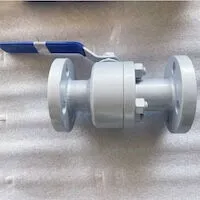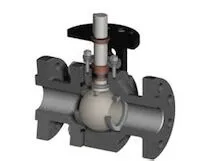Stainless Steel Valves
Dec 27, 2023
What is a stainless steel valve?
A stainless steel valve is a crucial component in various industries, including oil and gas, chemical processing, and power generation. It is a type of valve made from stainless steel, which is an alloy of iron and chromium. The addition of chromium provides the valve with excellent corrosion resistance properties, making it ideal for applications where exposure to harsh environments or corrosive substances is expected. Stainless steel valves are known for their durability and strength. They can withstand high temperatures and pressures without compromising their performance. This makes them suitable for critical operations that require reliable and long-lasting equipment.
In conclusion, a stainless steel valve is an essential component used in industries where reliability, durability, and resistance to corrosion are paramount. Its unique properties make it an ideal choice for critical applications that demand high performance under challenging conditions.
How to manufacture stainless steel valves?
Manufacturing a stainless steel valve requires precision, expertise, and meticulous attention to detail. This classic essay will outline the step-by-step process involved in creating this essential component. The first step in manufacturing a stainless steel valve is to select the appropriate grade of stainless steel. This decision is crucial as it determines the valve's durability and resistance to corrosion. Once the steel has been chosen, it is cut into the desired shape using specialized machinery. Next, the valve body is formed by shaping the cut pieces of stainless steel through processes such as forging or casting. Forging involves heating the metal and then hammering or pressing it into shape, while casting involves pouring molten metal into a mold and allowing it to solidify. After forming the valve body, various components such as stems, discs, seats, and seals are added. These components are typically made from different materials that complement the properties of stainless steel. Once all components have been assembled, they are welded together using techniques like TIG (Tungsten Inert Gas) welding or MIG (Metal Inert Gas) welding. Welding ensures that all parts are securely joined together. Finally, after welding, each valve undergoes rigorous testing to ensure its functionality and reliability. Tests may include pressure testing, leak testing, and performance testing under various conditions.
Classification of stainless steel valves
Stainless steel valves can be classified into different categories based on their design, function, and application. One classification of stainless steel valves is based on their structure. There are three main types: gate valves, globe valves, and ball valves. Gate valves have a sliding gate that controls the flow of fluid by either fully opening or closing the passage. Globe valves have a movable disk that regulates the flow by adjusting the space between the disk and seat. Ball valves use a rotating ball with a hole to control fluid flow. Another classification is based on their function. This includes isolation valves, which are used to completely shut off the flow; control valves, which regulate the flow rate; safety relief valves, which release excess pressure; and check valves, which allow one-way flow. Lastly, stainless steel valves can be classified according to their application in specific industries such as oil and gas, chemical processing, water treatment plants, pharmaceuticals, and food processing.
Advantages of stainless steel valves
One of the key advantages of stainless steel valves is their corrosion resistance. The chromium content forms a protective layer on the surface of the valve, preventing rusting or deterioration caused by moisture or chemicals. This feature ensures that the valve remains functional even in aggressive environments. Moreover, stainless steel valves offer versatility in terms of design options. They can be manufactured in various shapes and sizes to meet specific requirements. Additionally, they can be used for both manual operation and automated control systems.
The application of a stainless steel valve
The application of a stainless steel valve is crucial in various industries, ranging from oil and gas to chemical processing. Stainless steel valves are known for their durability, corrosion resistance, and high performance, making them an ideal choice for critical applications. One of the primary uses of stainless steel valves is in the oil and gas industry. These valves are employed in pipelines to control the flow of crude oil or natural gas. The harsh conditions, such as high pressure and corrosive substances, demand a material that can withstand such challenges. Stainless steel valves excel in this regard due to their resistance to corrosion and erosion. Chemical processing plants also heavily rely on stainless steel valves. These facilities handle aggressive chemicals that can deteriorate conventional materials rapidly. Stainless steel valves offer excellent resistance against chemical reactions, ensuring safe and efficient operations. Moreover, the food and beverage industry extensively utilizes stainless steel valves due to their hygienic properties. These valves prevent contamination during the manufacturing process by maintaining clean conditions.
Matters needing attention when installing stainless steel valves?
1. When loading, unloading and transporting stainless steel valves, it is not allowed to throw them casually to avoid damage.
2. When stacking stainless steel valves, they should be classified according to different specifications and models and stacked separately.
3. When lifting stainless steel valves, the rope should be tied to the flange connection between the valve body and the valve bonnet. Do not tie it to the handwheel or valve stem to avoid damaging the valve stem and handwheel.
4. When installing stainless steel valves on horizontal pipelines, the valve stem should be vertically upward and the valve stem should not be installed downward.
5. The rising stem gate valve should not be installed in a humid place underground to avoid corrosion of the valve stem.
A stainless steel valve is a crucial component in various industries, including oil and gas, chemical processing, and power generation. It is a type of valve made from stainless steel, which is an alloy of iron and chromium. The addition of chromium provides the valve with excellent corrosion resistance properties, making it ideal for applications where exposure to harsh environments or corrosive substances is expected. Stainless steel valves are known for their durability and strength. They can withstand high temperatures and pressures without compromising their performance. This makes them suitable for critical operations that require reliable and long-lasting equipment.
In conclusion, a stainless steel valve is an essential component used in industries where reliability, durability, and resistance to corrosion are paramount. Its unique properties make it an ideal choice for critical applications that demand high performance under challenging conditions.
How to manufacture stainless steel valves?
Manufacturing a stainless steel valve requires precision, expertise, and meticulous attention to detail. This classic essay will outline the step-by-step process involved in creating this essential component. The first step in manufacturing a stainless steel valve is to select the appropriate grade of stainless steel. This decision is crucial as it determines the valve's durability and resistance to corrosion. Once the steel has been chosen, it is cut into the desired shape using specialized machinery. Next, the valve body is formed by shaping the cut pieces of stainless steel through processes such as forging or casting. Forging involves heating the metal and then hammering or pressing it into shape, while casting involves pouring molten metal into a mold and allowing it to solidify. After forming the valve body, various components such as stems, discs, seats, and seals are added. These components are typically made from different materials that complement the properties of stainless steel. Once all components have been assembled, they are welded together using techniques like TIG (Tungsten Inert Gas) welding or MIG (Metal Inert Gas) welding. Welding ensures that all parts are securely joined together. Finally, after welding, each valve undergoes rigorous testing to ensure its functionality and reliability. Tests may include pressure testing, leak testing, and performance testing under various conditions.
Classification of stainless steel valves
Stainless steel valves can be classified into different categories based on their design, function, and application. One classification of stainless steel valves is based on their structure. There are three main types: gate valves, globe valves, and ball valves. Gate valves have a sliding gate that controls the flow of fluid by either fully opening or closing the passage. Globe valves have a movable disk that regulates the flow by adjusting the space between the disk and seat. Ball valves use a rotating ball with a hole to control fluid flow. Another classification is based on their function. This includes isolation valves, which are used to completely shut off the flow; control valves, which regulate the flow rate; safety relief valves, which release excess pressure; and check valves, which allow one-way flow. Lastly, stainless steel valves can be classified according to their application in specific industries such as oil and gas, chemical processing, water treatment plants, pharmaceuticals, and food processing.
Advantages of stainless steel valves
One of the key advantages of stainless steel valves is their corrosion resistance. The chromium content forms a protective layer on the surface of the valve, preventing rusting or deterioration caused by moisture or chemicals. This feature ensures that the valve remains functional even in aggressive environments. Moreover, stainless steel valves offer versatility in terms of design options. They can be manufactured in various shapes and sizes to meet specific requirements. Additionally, they can be used for both manual operation and automated control systems.
The application of a stainless steel valve
The application of a stainless steel valve is crucial in various industries, ranging from oil and gas to chemical processing. Stainless steel valves are known for their durability, corrosion resistance, and high performance, making them an ideal choice for critical applications. One of the primary uses of stainless steel valves is in the oil and gas industry. These valves are employed in pipelines to control the flow of crude oil or natural gas. The harsh conditions, such as high pressure and corrosive substances, demand a material that can withstand such challenges. Stainless steel valves excel in this regard due to their resistance to corrosion and erosion. Chemical processing plants also heavily rely on stainless steel valves. These facilities handle aggressive chemicals that can deteriorate conventional materials rapidly. Stainless steel valves offer excellent resistance against chemical reactions, ensuring safe and efficient operations. Moreover, the food and beverage industry extensively utilizes stainless steel valves due to their hygienic properties. These valves prevent contamination during the manufacturing process by maintaining clean conditions.
Matters needing attention when installing stainless steel valves?
1. When loading, unloading and transporting stainless steel valves, it is not allowed to throw them casually to avoid damage.
2. When stacking stainless steel valves, they should be classified according to different specifications and models and stacked separately.
3. When lifting stainless steel valves, the rope should be tied to the flange connection between the valve body and the valve bonnet. Do not tie it to the handwheel or valve stem to avoid damaging the valve stem and handwheel.
4. When installing stainless steel valves on horizontal pipelines, the valve stem should be vertically upward and the valve stem should not be installed downward.
5. The rising stem gate valve should not be installed in a humid place underground to avoid corrosion of the valve stem.
Previous: Different Types of Wedge Gate Valves
Next: What Factors Need to Be Considered When Designing Valves in Chemical Process?


